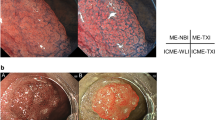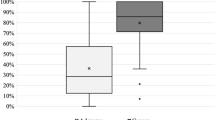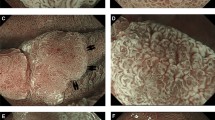Abstract
Background
This study aimed to clarify the features of superficial non-ampullary duodenal epithelial tumors (SNADETs) on magnifying endoscopy with narrow-band imaging (M-NBI) and magnifying endoscopy with acetic acid and narrow-band imaging (M-AANBI), and evaluate the efficacy of M-NBI/M-AANBI to distinguish high-grade adenomas or adenocarcinomas (HGA/AC) from low-grade adenomas (LGA).
Methods
Clinicopathological data on 62 SNADETs in 58 patients who underwent preoperative M-NBI/M-AANBI and endoscopic resection were retrospectively reviewed. The pathological results were classified into two categories, LGA and HGA/AC. We evaluated microvascular patterns (MVPs) and microsurface patterns (MSPs) observed by M-NBI and MSPs observed by M-AANBI for characterizing LGA and HGA/AC. The kappa value was calculated to assess the interobserver and intraobserver agreements of evaluation of M-AANBI images.
Results
Pathologically, 38 lesions (61.3%) were LGA and 24 lesions (38.7%) were HGA/AC. HGA/AC tended to have irregular MVP and/or MSP on M-NBI. M-NBI diagnostic performance to distinguish HGA/AC from LGA showed 62.5% sensitivity, 68.4% specificity, and 66.1% accuracy. SNADETs had irregular MSP on M-AANBI. Three irregularity grades (iG) of MSP were observed by M-AANBI as follows: iG1, mild; iG2, moderate; iG3, significant. HGA/AC lesions had a significantly higher rate of iG3 than LGA lesions (p < 0.001). The iG2 was associated with HGA/AC in elevated lesions and LGA in depressed lesions. The diagnostic performance of M-AANBI was as follows: 95.8% sensitivity, 97.4% specificity, and 96.8% accuracy. The diagnostic accuracy of M-AANBI was significantly higher than that of M-NBI (p < 0.001). The kappa value for interobserver agreement on the diagnosis and irregularity grading of M-AANBI images was 0.742 and 0.719, respectively. These data indicate substantial interobserver agreement. Based on the above-mentioned results, we developed a M-AANBI diagnostic algorithm for SNADETs.
Conclusion
The diagnostic algorithm for SNADETs using M-AANBI may be useful for differentiating between LGA and HGA/AC.








Similar content being viewed by others
References
Alwmark A, Andersson A, Lasson A (1980) Primary carcinoma of the duodenum. Ann Surg 191:13–18
Qubaiah O, Devesa SS, Platz CE, Huycke MM, Dores GM (2010) Small intestinal cancer: a population-based study of incidence and survival patterns in the United States, 1992 to 2006. Cancer Epidemiol Biomarkers Prev 19:1908–1918
Schottenfeld D, Beebe-Dimmer JL, Vigneau FD (2009) The epidemiology and pathogenesis of neoplasia in the small intestine. Ann Epidemiol 19:58–69
Bojesen RD, Andersson M, Riis LB, Nielsen OH, Jess T (2016) Incidence of, phenotypes of and survival from small bowel cancer in Denmark, 1994–2010: a population-based study. J Gastroenterol 51:891–899
Legue LM, Bernards N, Gerritse SL, van Oudheusden TR, de Hingh IH, Creemers GM, Ten Tije AJ, Lemmens VE (2016) Trends in incidence, treatment and survival of small bowel adenocarcinomas between 1999 and 2013: a population-based study in The Netherlands. Acta Oncol 55:1183–1189
Lu Y, Frobom R, Lagergren J (2012) Incidence patterns of small bowel cancer in a population-based study in Sweden: increase in duodenal adenocarcinoma. Cancer Epidemiol 36:e158–e163
Goda K, Kikuchi D, Yamamoto Y, Takimoto K, Kakushima N, Morita Y, Doyama H, Gotoda T, Maehata Y, Abe N (2014) Endoscopic diagnosis of superficial non-ampullary duodenal epithelial tumors in Japan: Multicenter case series. Dig Endosc 26(Suppl 2):23–29
Kakushima N, Kanemoto H, Tanaka M, Takizawa K, Ono H (2014) Treatment for superficial non-ampullary duodenal epithelial tumors. World J Gastroenterol 20:12501–12508
Nonaka S, Oda I, Tada K, Mori G, Sato Y, Abe S, Suzuki H, Yoshinaga S, Nakajima T, Matsuda T, Taniguchi H, Saito Y, Maetani I (2015) Clinical outcome of endoscopic resection for nonampullary duodenal tumors. Endoscopy 47:129–135
Hoteya S, Furuhata T, Takahito T, Fukuma Y, Suzuki Y, Kikuchi D, Mitani T, Matsui A, Yamashita S, Nomura K, Kuribayashi Y, Iizuka T, Kaise M (2017) Endoscopic submucosal dissection and endoscopic mucosal resection for non-ampullary superficial duodenal tumor. Digestion 95:36–42
Kinoshita S, Nishizawa T, Ochiai Y, Uraoka T, Akimoto T, Fujimoto A, Maehata T, Goto O, Kanai T, Yahagi N (2017) Accuracy of biopsy for the preoperative diagnosis of superficial nonampullary duodenal adenocarcinoma. Gastrointest Endosc 86:329–332
Kakushima N, Ono H, Takao T, Kanemoto H, Sasaki K (2014) Method and timing of resection of superficial non-ampullary duodenal epithelial tumors. Dig Endosc 26(Suppl 2):35–40
Kikuchi D, Hoteya S, Iizuka T, Kimura R, Kaise M (2014) Diagnostic algorithm of magnifying endoscopy with narrow band imaging for superficial non-ampullary duodenal epithelial tumors. Dig Endosc 26(Suppl 2):16–22
Tsuji S, Doyama H, Tsuji K, Tsuyama S, Tominaga K, Yoshida N, Takemura K, Yamada S, Niwa H, Katayanagi K, Kurumaya H, Okada T (2015) Preoperative endoscopic diagnosis of superficial non-ampullary duodenal epithelial tumors, including magnifying endoscopy. World J Gastroenterol 21:11832–11841
Mizumoto T, Sanomura Y, Tanaka S, Kuroki K, Kurihara M, Yoshifuku Y, Oka S, Arihiro K, Shimamoto F, Chayama K (2017) Clinical usefulness of magnifying endoscopy for non-ampullary duodenal tumors. Endosc Int Open 5:E297–E302
Nakayama A, Kato M, Takatori Y, Shimoda M, Mizutani M, Tsutsumi K, Kiguchi Y, Akimoto T, Sasaki M, Mutaguchi M, Takabayashi K, Maehata T, Ochiai Y, Kanai T, Yahagi N (2020) How I do it: Endoscopic diagnosis for superficial non-ampullary duodenal epithelial tumors. Dig Endosc 32:417–424
Tanaka Y, Fujii S, Oiwa Y, Kusaka T, Shibuya S, Kokuryu H (2021) Efficacy of magnifying narrow band imaging with acetic acid spray in diagnosing superficial non-ampullary duodenal epithelial tumors. Digestion 102:572–579
Yamasaki Y, Takeuchi Y, Kanesaka T, Kanzaki H, Kato M, Ohmori M, Tonai Y, Hamada K, Matsuura N, Iwatsubo T, Akasaka T, Hanaoka N, Higashino K, Uedo N, Ishihara R, Okada H, Iishi H (2020) Differentiation between duodenal neoplasms and non-neoplasms using magnifying narrow-band imaging - Do we still need biopsies for duodenal lesions? Dig Endosc 32:84–95
Tanaka K, Toyoda H, Inoue H, Hamada Y, Aoki M, Kosaka R, Takamura M, Imoto I (2007) Depressed-type early duodenal carcinoma (carcinoma in situ) observed by enhanced magnification endoscopy. Endoscopy 39(Suppl 1):E125–E126
Kadowaki S, Tanaka K, Toyoda H, Kosaka R, Imoto I, Hamada Y, Katsurahara M, Inoue H, Aoki M, Noda T, Yamada T, Takei Y, Katayama N (2009) Ease of early gastric cancer demarcation recognition: a comparison of four magnifying endoscopy methods. J Gastroenterol Hepatol 24:1625–1630
Shibagaki K, Amano Y, Ishimura N, Taniguchi H, Fujita H, Adachi S, Kakehi E, Fujita R, Kobayashi K, Kinoshita Y (2016) Diagnostic accuracy of magnification endoscopy with acetic acid enhancement and narrow-band imaging in gastric mucosal neoplasms. Endoscopy 48:16–25
Tanaka K, Toyoda H, Jaramillo E (2008) Magnifying endoscopy in combination with narrow-band imaging and acetic acid instillation in the diagnosis of Barrett’s esophagus. In: Tajiri H, Nakajima M, Yasuda K (eds) New challenges in gastrointestinal endoscopy. Springer, Tokyo, pp 153–160
Okada K, Fujisaki J, Kasuga A, Omae M, Kubota M, Hirasawa T, Ishiyama A, Inamori M, Chino A, Yamomoto Y, Tsuchida T, Nakajima A, Hoshino E, igarashi M, (2011) Sporadic nonampullary duodenal adenoma in the natural history of duodenal cancer: a study of follow-up surveillance. Am J Gastroenterol 106:357–364
Maruoka D, Matsumura T, Kasamatsu S, Ishigami H, Taida T, Okimoto K, Nakagawa T, Katsuno T, Arai M (2017) Cold polypectomy for duodenal adenomas: a prospective clinical trial. Endoscopy 49:776–783
Irino T, Nunobe S, Hiki N, Yamamoto Y, Hirasawa T, Ohashi M, Fujisaki J, Sano T, Yamaguchi T (2015) Laparoscopic-endoscopic cooperative surgery for duodenal tumors: a unique procedure that helps ensure the safety of endoscopic submucosal dissection. Endoscopy 47:349–351
Binmoeller KF, Shah JN, Bhat YM, Kane SD (2013) “Underwater” EMR of sporadic laterally spreading nonampullary duodenal adenomas (with video). Gastrointest Endosc 78:496–502
Acknowledgements
The authors thank the medical staff members of the Departments of Endoscopy, Gastroenterology and Pathology of Mie University Hospital, for their contribution to this work. We also thank NAI Inc. (Yokohama, Japan) for reviewing the English.
Funding
None.
Author information
Authors and Affiliations
Corresponding author
Additional information
Publisher's Note
Springer Nature remains neutral with regard to jurisdictional claims in published maps and institutional affiliations.
Supplementary Information
Below is the link to the electronic supplementary material.
Supplementary file1 (MP4 31909 KB)
Supplementary file2 (MP4 30313 KB)
Rights and permissions
About this article
Cite this article
Miura, H., Tanaka, K., Umeda, Y. et al. Usefulness of magnifying endoscopy with acetic acid and narrow-band imaging for the diagnosis of duodenal neoplasms: proposal of a diagnostic algorithm. Surg Endosc 36, 8086–8095 (2022). https://doi.org/10.1007/s00464-022-09239-1
Received:
Accepted:
Published:
Issue Date:
DOI: https://doi.org/10.1007/s00464-022-09239-1




